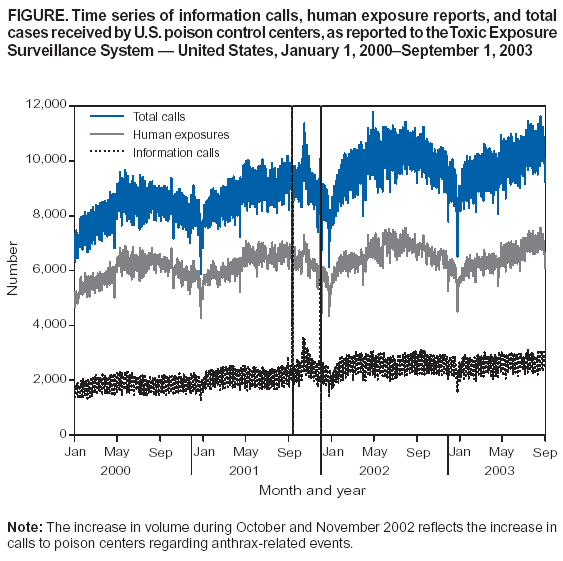 |
|
|
|
|
|
|
| ||||||||||
|
|
|
|
|
|
|
||||
| ||||||||||
|
|
|
|
|
Persons using assistive technology might not be able to fully access information in this file. For assistance, please send e-mail to: mmwrq@cdc.gov. Type 508 Accommodation and the title of the report in the subject line of e-mail. Toxic Exposure Surveillance SystemWilliam A.Watson,1 T.
Litovitz,1 C. Rubin,2 E. Kilbourne,3 M. Belson,2 M. Patel,2 J. Schier,2 A. Funk2
Corresponding author: William A. Watson, American Association of Poison Control Centers, 3201 New Mexico Ave., N.W., Suite 330, Washington, D.C. 20016. Telephone: 202-363-7630; Fax: 202-362-3240; E-mail: watson@poison.org. AbstractIntroduction: The Toxic Exposure Surveillance System (TESS) is a national, real-time surveillance database that includes all human exposures reported to participating U.S. poison control centers since 1985. More than36 million human poison exposures have occurred since December 2002. The database is continuously updated, with approximately 6,500 new human exposure cases added daily. Objectives: This paper describes TESS and the current toxicosurveillance methods being applied to TESS for earliest possible identification of potential instances of chemical terrorism and other events of potential public health importance that require additional investigation. Methods: Poisoning cases are managed and entered into TESS by poison-information specialists at each U.S. poison control center. The specialists collect data as part of triage and case management and code these data according to standardized definitions. Approximately 44% of cases receive follow-up, allowing for determination of the clinical course and outcome of the exposure. TESS searches for aberrations in hourly case volume for each poison control center and for daily frequency of clinical effects. Multiple surveillance case definitions and queries for presence of specific substances are used to identify possible sentinel cases for review. Query results are interpreted by clinical toxicologists, and individual cases producing signals are reviewed for clinical and surveillance significance. Reporting poison control centers are contacted for additional information as needed. Results: Daily total case counts demonstrate the effect of the anthrax-related events of October--November 2001 on poison center case volume, with an increase in both information and human exposure cases (Figure). An increase in calls to the New York City Poison Control Center regarding food poisoning and what to do with spoiled food after the power blackout of August 2003 demonstrated the potential for TESS data to identify local changes in specific call types that might not be recognized in national data. TESS surveillance detected the malicious contamination of coffee with arsenic in Maine. Local and federal chemical and biologic terrorism-preparedness exercises have also generated surveillance signals. Conclusions: TESS adds a real-time set of toxicity data to national, regional, and local surveillance that can rapidly identify local and national events of public health importance, including intentional chemical attacks. Figure  Return to top.
Disclaimer All MMWR HTML versions of articles are electronic conversions from ASCII text into HTML. This conversion may have resulted in character translation or format errors in the HTML version. Users should not rely on this HTML document, but are referred to the electronic PDF version and/or the original MMWR paper copy for the official text, figures, and tables. An original paper copy of this issue can be obtained from the Superintendent of Documents, U.S. Government Printing Office (GPO), Washington, DC 20402-9371; telephone: (202) 512-1800. Contact GPO for current prices. **Questions or messages regarding errors in formatting should be addressed to mmwrq@cdc.gov.Page converted: 10/4/2004 |
|||||||||
This page last reviewed 10/4/2004
|